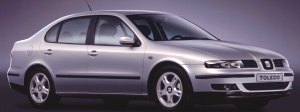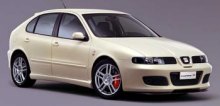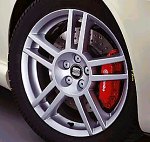 When
the Spanish subsidiary was causing too much headache to Dr. Piech, he
might
be wondering the lack of quality concept in Latin people's mind. 10
years
after acquired SEAT from the hands of Fiat, the former still build
cheap
cars of below standard quality. He might wonder how another Latin
brand,
Alfa Romeo, solved this problem. "Alfa Romeo ?" he found the target for
his SEAT. When
the Spanish subsidiary was causing too much headache to Dr. Piech, he
might
be wondering the lack of quality concept in Latin people's mind. 10
years
after acquired SEAT from the hands of Fiat, the former still build
cheap
cars of below standard quality. He might wonder how another Latin
brand,
Alfa Romeo, solved this problem. "Alfa Romeo ?" he found the target for
his SEAT.
Inevitably, under Dr. Piech's global strategy the new Toledo is heavily based on Golf IV platform, or more precisely the sedan version Bora. 65% parts should be common to its sisters names A3, Octavia, Golf and Bora, and to lesser extent the Beetle and TT. Production was simply moved to VW's plant in Belgium in order to relief Dr. Piech's headache. Piech always talk about Latin emotion of the new Toledo. Don't fool me ! Open the internal record we'll see sentences like "Made in Belgium", "Engineered in Germany" and "5-valve engine supplied by Hungarian". He might believe Mr. Giugiaro's Italdesign injected Latin emotion into the round body, but the actual car looks more like any Daewoo recently penned by the same studio. It looks like the new BMW 3-Series too, just a bit more boring. Piech raised the game of badge-engineering to the highest level ever seen - SEAT didn't involve the car at all except donated the badge. Anyway, car buying public only cares how good the car is. Therefore we're going to explore a Toledo V5 which is not only the top of the range but also in my opinion the best buy of the range. Jewel of the crown is the narrow angle, 2324c.c. V5 engine carried over from Golf. It's really an engineering achievement : in the compact size of a 4-pot, it delivers smoothness of a V6. Despite of the absence of multi-valve and VVT, its extra capacity enables a remarkable 150hp output and 151lbft/3200rpm, roughly equals to Audi's 1.8T. What the number can't show is the abundance of torque at low and mid range which greatly enhance Toledo's overtaking ability. Smooth, willing, torquey and ease of use characterise the V5. The next thing to be praised is build quality. Forget the old Spanish Seat, this is a typical Volkswagen. The familiar dashboard is borrow directly from Audi A3, which is made of quality plastic although lacks the classy feel of Golf's. Space is sufficient in the front but suffers in the rear, especially is leg room which is limited by Golf's wheelbase. If there is anything preventing the Toledo from competing with Ford Mondeo / Peugeot 406 / Opel Vectra etc. (as wishes Volkswagen), it must be the rear passenger room. However, to enthusiasts like us, its fatal fault is the Golf-like handling. Low-specified strut / torsion beam suspensions marry with the incapable tuning from VW result in less than happy body control on demanding road. Going quickly into bend result in understeer and body roll more than expected. Steering feel, as in Golf, fails to inspire the driver. After all, Toledo is still a German kind of highway cruiser offering exceptional refinement, safe feel and ease of drive. Latin emotion ? Forget it. Overall speaking
it is not
so bad, especially when you look at the price tag : at £17,600
you
get a generous lists of equipment including 6-CD changer, digital
climate
control, power leather seats, 4 air bags, alloy wheels and trip
computer.
Simply irresistible ! For such an aggressive pricing please give thanks
to platform sharing as well as SEAT's tradition. However, in the world
of real drivers, the new Toledo is not (and by far not) the Alfa-beater.
|
| The above report was last updated on 15 May 99. All Rights Reserved. |
 Leon
is the hatchback version of Toledo, or the last mainstream derivative
of
the Golf IV family. Although being strictly 5-door only, Leon is
probably
the most handsome car among its family members. The hatchback design is
somewhat similar to Rover 200 (now calls 25), with a tilted rear window
enhancing sporty image but also limiting cargo-carrying ability. It's
subtle
nose even looks like a BMW 3-series, so is build quality outside and
inside.
Leon
is the hatchback version of Toledo, or the last mainstream derivative
of
the Golf IV family. Although being strictly 5-door only, Leon is
probably
the most handsome car among its family members. The hatchback design is
somewhat similar to Rover 200 (now calls 25), with a tilted rear window
enhancing sporty image but also limiting cargo-carrying ability. It's
subtle
nose even looks like a BMW 3-series, so is build quality outside and
inside.
 While
Ibiza Cupra represents raw performance, the Leon Cupra 4 shines in
refined
performance. Such inconsistent brand identity is simply the outcome of
components / platform sharing. If we say Leon is Seat's version of
Golf,
the Leon Cupra 4 will be the equivalent of Golf V6 4motion. In fact,
the
whole 204 hp narrow-angle V6, 6-speed manual transmission, Haldex
4-wheel
drive and even the sub-frame-mounted multi-link rear suspension are
carried
over from the top Golf.
While
Ibiza Cupra represents raw performance, the Leon Cupra 4 shines in
refined
performance. Such inconsistent brand identity is simply the outcome of
components / platform sharing. If we say Leon is Seat's version of
Golf,
the Leon Cupra 4 will be the equivalent of Golf V6 4motion. In fact,
the
whole 204 hp narrow-angle V6, 6-speed manual transmission, Haldex
4-wheel
drive and even the sub-frame-mounted multi-link rear suspension are
carried
over from the top Golf.
 With
the introduction Cupra R, the position of Cupra 4 is quite
embarrassing.
Undeniably, the 4-wheel-drive and V6-powered Cupra 4 is the most
sophisticated
and expensive car Seat ever produced. However, it is also overweight,
tipping
the scale at 1575kg, hence limiting its performance and handling
sharpness.
That means it can never challenge the like of Subaru Impreza WRX, not
even
close sister Audi S3.
With
the introduction Cupra R, the position of Cupra 4 is quite
embarrassing.
Undeniably, the 4-wheel-drive and V6-powered Cupra 4 is the most
sophisticated
and expensive car Seat ever produced. However, it is also overweight,
tipping
the scale at 1575kg, hence limiting its performance and handling
sharpness.
That means it can never challenge the like of Subaru Impreza WRX, not
even
close sister Audi S3.
 By using a 4-pot engine and
by ditching the 4-wheel-drive system together with the heavier
multi-link
rear suspension on which the Haldex differential mounted, the Cupra R
is
180kg lighter than the Cupra 4. It also has a little more power and the
same peak torque, while both drive through a 6-speed gearbox. Therefore
performance is improved. Now the new car tops 147mph and sprints from
rest
to 60mph in 6.8 seconds.
By using a 4-pot engine and
by ditching the 4-wheel-drive system together with the heavier
multi-link
rear suspension on which the Haldex differential mounted, the Cupra R
is
180kg lighter than the Cupra 4. It also has a little more power and the
same peak torque, while both drive through a 6-speed gearbox. Therefore
performance is improved. Now the new car tops 147mph and sprints from
rest
to 60mph in 6.8 seconds.  The
Cupra R also has a pair
of superb Recaro seats and some alloy touches in the cockpit.
Nevertheless,
all come at a price - in UK, it is priced at approx. £19,000,
expensive
for a front-drive hot hatch without a prestige badge. For similar
performance,
you can have Civic Type R and Renault Clio RS at under £16,000.
Moreover,
the Cupra R is no more fun to drive. Yes, it has tremendous torque,
roadholding
and braking, but it is not as flickable in twisting roads. Basically,
throttle
adjustability is not what Golf IV platform renowned for, especially for
a version weighing nearly 1400kg (don't know why it can be heavier than
S3 Quattro). The steering, though quick and precise, and perhaps
communicate
better than Type R and Clio (we have never praised them, remember), is
upset by torque steer when accelerating out of corner. Ride quality
also
suffers from big bumps where most other hot hatches can overcome. On
motorway
it rides smoothly.
The
Cupra R also has a pair
of superb Recaro seats and some alloy touches in the cockpit.
Nevertheless,
all come at a price - in UK, it is priced at approx. £19,000,
expensive
for a front-drive hot hatch without a prestige badge. For similar
performance,
you can have Civic Type R and Renault Clio RS at under £16,000.
Moreover,
the Cupra R is no more fun to drive. Yes, it has tremendous torque,
roadholding
and braking, but it is not as flickable in twisting roads. Basically,
throttle
adjustability is not what Golf IV platform renowned for, especially for
a version weighing nearly 1400kg (don't know why it can be heavier than
S3 Quattro). The steering, though quick and precise, and perhaps
communicate
better than Type R and Clio (we have never praised them, remember), is
upset by torque steer when accelerating out of corner. Ride quality
also
suffers from big bumps where most other hot hatches can overcome. On
motorway
it rides smoothly.